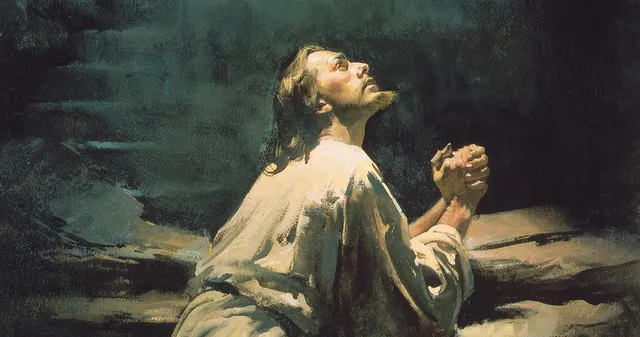
FAIR is a non-profit organization dedicated to providing well-documented answers to criticisms of the doctrine, practice, and history of The Church of Jesus Christ of Latter-day Saints.
“O How Great the Plan of Our God”

“O How Great the Plan of Our God”
FAIR Faithful Resources for Come, Follow Me 2024 February 19-25. 2 Nephi 6-10: “O How Great the Plan of Our God”. These trusted sources can help you find answers to difficult questions and help you in your learning and teaching.
Jump to section

The lesson invites us to challenge our assumptions about the “curse that came upon the Lamanites”(see 2 Nephi 5:20–21). As you ponder this question, the following questions and sources may be helpful:
This Gospel Topic essay may also prove useful: Race and the Priesthood

1-5: Nephi shares one of Jacob’s sermons, in which he quotes Isaiah and speak of things to come. He is concerned about the trajectory the Nephites seem to be traveling on.
6-18: In verses 6-7 of 2 Nephi 6, Jacob quotes Isaiah 49:23-24 and verses 16-18 are Isaiah 24-26. Jacob states that though Jerusalem was destroyed, the Jews will return. However, they will reject the Messiah when he comes and be scattered again. However, the Lord will not forget His covenant people. They will have the opportunity to accept the Savior, reject wickedness and be redeemed.
(compare to Isaiah 50:1-18)
1-3: Due to their sins, the children of Israel have distanced themselves from God, though He yet is willing to use His power to save and redeem.
4-9: The Savior references some of the hardships of His coming mission. However, he will be victorious.
10-11: If we try to walk in our own light we will be unsuccessful. Our efforts will not create lasting light.
(compare to Isaiah 51:1-23 and Isaiah 52:1-2)
1-10: The Lord asks His covenant people to remember His love, His constancy, His power and His ability to redeem.
11-23: Though Israel has at times rejected the Lord, they will be brought back from exile. Though the Lord has allowed them to suffer at times (drink the dregs . .), He is anxious to offer help and redemption and fight their enemies.
24-25: A final call for Israel to awaken, shake off those things that impede their spiritual progress and clothe themselves in the strength and righteousness of God.
1-3: Jacob continues preaching, explaining and expounding on the words of Isaiah. Israel should rejoice, confident that they will be gathered and receive their promised inheritance.
4-13: Jacob’s powerful sermon on the mission of the Savior – His infinite atonement. He saves us from both physical and spiritual death, the one brought about by the fall and the other due to our sins.
14-38: Jacob speaks of the final judgment. The Savior’s atonement and our subsequent faith, covenants and ordinances enable us to live with Him and the Father eternally. However, woe unto those who reject His teachings and are led astray by Satan. The atonement satisfies the demands of justice.
39-54: Jacob pleads with his people to give heed to the message just shared. Though hard to hear and implement, it is the way of happiness and salvation.
1-2: Jacob continues preaching, possibly the next day, emphasizing that though they are a “broken branch” of the House of Israel, and though many will perish due to unbelief, they will one day be restored as a covenant people.
3-9: This will come as they accept Jesus, the Christ. When He comes to Jerusalem, He will be rejected by the Jews, causing their additional scattering. When they accept Jesus as the Messiah, their promised blessings will come to pass. Until that time, the Gentiles shall be like a parent to scattered Israel.
10-19: Those living in the Americas, both Gentile and the descendants of Lehi, will be blessed, particularly as they give heed to the word of God.
20-25: Jacob pleads that the Nephites will joyfully choose to follow God and walk in His ways. Great blessings are in store for them if they do.


Endnotes
1 David A. Bednar, “The Atonement and the Journey of Mortality,” Ensign, April 2012, ChurchofJesusChrist.org.
2 Discourse by Wilford Woodruff, July 29, 1889, p. 1, The Wilford Woodruff Papers, wilfordwoodruffpapers.org/discourse/1889-07-29.

Michelle Pack
Michelle graduated from Utah State University–Eastern in 1995 with an associate degree in Graphic Design. After serving in the Guatemala, Guatemala North Mission from 1996 to 1998, she continued her education at Utah Valley University, graduating in 1999 with an associate degree in Paralegal Studies and in 2000 with a bachelor’s degree in Technology Management and an emphasis in Graphic Design. She worked as a paralegal for two years before having her children and becoming a full-time stay-at-home mom. Her two children are now in college. Not wanting to let her children suffer through college alone, Michelle went back to school and is now attending Utah Tech University, working on her master’s in Technical Writing and Digital Rhetoric. Michelle loves the gospel, family history, and the temple. She and her husband enjoy camping, hiking, and spending time together. She is excited to be a volunteer with the Wilford Woodruff Papers.

Lesson devotionals are provided by the Wilford Woodruff Papers Foundation. Its mission is to digitally preserve and publish Wilford Woodruff’s eyewitness account of the Restoration of the gospel of Jesus Christ from 1833 to 1898. It seeks to make Wilford Woodruff’s records universally accessible to inspire all people, especially the rising generation, to study and to increase their faith in Jesus Christ. See wilfordwoodruffpapers.org.

FAIR is a non-profit organization dedicated to providing well-documented answers to criticisms of the doctrine, practice, and history of The Church of Jesus Christ of Latter-day Saints.
We are a volunteer organization. We invite you to give back.
Donate Now